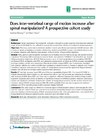| dc.contributor.author | Branney, Jonathan | |
| dc.contributor.author | Breen, Alan | |
| dc.date.accessioned | 2019-02-07T16:29:40Z | |
| dc.date.available | 2019-02-07T16:29:40Z | |
| dc.date.issued | 2014 | |
| dc.identifier.citation | Branney, J. and Breen, A., 2014. Does inter-vertebral range of motion increase after spinal manipulation? A prospective cohort study. Chiropractic and Manual Therapies, 22:24 https://doi.org/10.1186/s12998-014-0024-9 | en |
| dc.identifier.issn | 2045-709X | |
| dc.identifier.uri | https://aecc.archive.knowledgearc.net/handle/123456789/51 | |
| dc.description | Available under License - Creative Commons Attribution: https://creativecommons.org/licenses/by/4.0/ | en |
| dc.description.abstract | Background: Spinal manipulation for nonspecific neck pain is thought to work in part by improving inter-vertebral range of motion (IV-RoM), but it is difficult to measure this or determine whether it is related to clinical outcomes.
Objectives: This study undertook to determine whether cervical spine flexion and extension IV-RoM increases after a course of spinal manipulation, to explore relationships between any IV-RoM increases and clinical outcomes and to compare palpation with objective measurement in the detection of hypo-mobile segments.
Method: Thirty patients with nonspecific neck pain and 30 healthy controls matched for age and gender received quantitative fluoroscopy (QF) screenings to measure flexion and extension IV-RoM (C1-C6) at baseline and 4-week follow-up between September 2012-13. Patients received up to 12 neck manipulations and completed NRS, NDI and Euroqol 5D-5L at baseline, plus PGIC and satisfaction questionnaires at follow-up. IV-RoM accuracy, repeatability and hypo-mobility cut-offs were determined. Minimal detectable changes (MDC) over 4 weeks were calculated from controls. Patients and control IV-RoMs were compared at baseline as well as changes in patients over 4 weeks. Correlations between outcomes and the number of manipulations received and the agreement (Kappa) between palpated and QF-detected of hypo-mobile segments were calculated.
Results: QF had high accuracy (worst RMS error 0.5o) and repeatability (highest SEM 1.1o, lowest ICC 0.90) for IV-RoM measurement. Hypo-mobility cut offs ranged from 0.8o to 3.5o. No outcome was significantly correlated with increased IV-RoM above MDC and there was no significant difference between the number of hypo-mobile segments in patients and controls at baseline or significant increases in IV-RoMs in patients. However, there was a modest and significant correlation between the number of manipulations received and the number of levels and directions whose IV-RoM increased beyond MDC (Rho=0.39, p=0.043). There was also no agreement between palpation and QF in identifying hypo-mobile segments (Kappa 0.04-0.06).
Conclusions: This study found no differences in cervical sagittal IV-RoM between patients with non-specific neck pain and matched controls. There was a modest dose-response relationship between the number of manipulations given and number of levels increasing IV-RoM - providing evidence that neck manipulation has a mechanical effect at segmental levels. However, patient-reported outcomes were not related to this. | en |
| dc.language.iso | en | en |
| dc.publisher | Chiropractic and Manual Therapies | en |
| dc.title | Does inter-vertebral range of motion increase after spinal manipulation? A prospective cohort study | en |
| dc.type | Article | en |
| dc.identifier.doi | https://doi.org/10.1186/s12998-014-0024-9 | |
